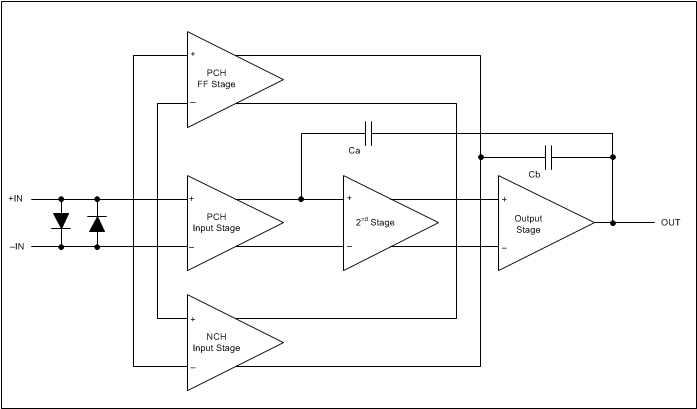SBOS735 September 2015 OPA2171-EP
PRODUCTION DATA.
- 1 Features
- 2 Applications
- 3 Description
- 4 Revision History
- 5 Pin Configuration and Functions
- 6 Specifications
- 7 Detailed Description
- 8 Application and Implementation
- 9 Power Supply Recommendations
- 10Layout
- 11Device and Documentation Support
- 12Mechanical, Packaging, and Orderable Information
Package Options
Mechanical Data (Package|Pins)
- DCU|8
Thermal pad, mechanical data (Package|Pins)
Orderable Information
7 Detailed Description
7.1 Overview
The OPA2171-EP operational amplifier provides high overall performance, making it ideal for many general-purpose applications. The excellent offset drift of only 2 µV/°C provides excellent stability over the entire temperature range. In addition, the device offers very good overall performance with high CMRR, PSRR, and AOL. As with all amplifiers, applications with noisy or high-impedance power supplies require decoupling capacitors close to the device pins. In most cases, 0.1-µF capacitors are adequate.
7.2 Functional Block Diagram

7.3 Feature Description
7.3.1 Operating Characteristics
The OPA2171-EP amplifier is specified for operation from 2.7 to 36 V (±1.35 to ±18 V). Many of the specifications apply from –55°C to 125°C. Parameters that can exhibit significant variance with regard to operating voltage or temperature are presented in Typical Characteristics.
7.3.2 Phase-Reversal Protection
The OPA2171-EP has an internal phase-reversal protection. Many operational amplifiers exhibit a phase reversal when the input is driven beyond its linear common-mode range. This condition is most often encountered in noninverting circuits when the input is driven beyond the specified common-mode voltage range, causing the output to reverse into the opposite rail. The input of the OPA2171-EP prevents phase reversal with excessive common-mode voltage. Instead, the output limits into the appropriate rail. Figure 37 shows this performance.
 Figure 37. No Phase Reversal
Figure 37. No Phase Reversal
7.4 Device Functional Modes
7.4.1 Common-Mode Voltage Range
The input common-mode voltage range of the OPA2171-EP extends 100 mV below the negative rail and within 2 V of the top rail for normal operation.
This device can operate with full rail-to-rail input 100 mV beyond the top rail, but with reduced performance within 2 V of the top rail. Table 2 summarizes the typical performance in this range.
Table 2. Typical Performance Range
| PARAMETER | MIN | TYP | MAX | UNIT | |
|---|---|---|---|---|---|
| Input Common-Mode Voltage | (V+) – 2 | (V+) + 0.1 | V | ||
| Offset voltage | 7 | mV | |||
| vs Temperature | 12 | µV/°C | |||
| Common-mode rejection | 65 | dB | |||
| Open-loop gain | 60 | dB | |||
| GBW | 0.7 | MHz | |||
| Slew rate | 0.7 | V/µs | |||
| Noise at ƒ = 1kHz | 30 | nV/√Hz | |||